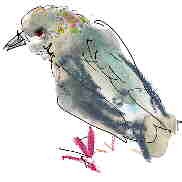|
Just imagine,
for a moment, that homeopathy is a real "phenomenon" and that
it has been demonstrated to work again and again, but because we do
not understand how it works, orthodox thinkers reject it. For a moment
suspend disbelief...
On February the 17th, 1989,
MAME came to see us. MAME had stumbled upon a molecular demonstration
of homeopathy.
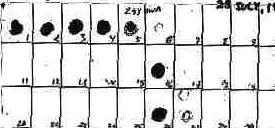
The implications
are ... I don't know how to describe... start with astounding, profound.
"Us"
was Professor Pomeranz of the University of Toronto,
and his research team, of which I was a
member; and MAME, which is my name for Professor Mounir
AbouHaidar and his colleagues, Dr. Mohammed Eweida and Michael Dobbs.
At the time they came to us they came in confidence, so I got
into the habit of calling them cryptically
MAME.
MAME
found that a solution of viral DNA, diluted beyond substance in the
manner of homeopathy, can physically bind its substantial, molecular,
complementary strand. This implies that the water "remembers"
the substance that was in it. It behaves as though the DNA - even though
diluted beyond substance - were still there. The ramifications
of this phenomenon deeply effects ours understanding of physics, medicine,
and of psychology, and as I hope to explain may prove to be a key to
our understanding consciousness.

In
Prof. AbouHaidar's viral assay a solution of DNA, the genetic ribbon
- even after it has been serially diluted until there was no substance
left - binds its labeled complementary strand. This means water can
be patterned; can carry a signal, and in this sense "remembers".
Water prefers to be ordered, to be patterned, prefers this to our usual
conception of liquid as random. Water is stressed by, rather than enjoying
amorphous chaos. It prefers to be organized, to behave like a crystal.
So water takes whatever substance we put in it, be that salt, or sulphur,
or viral DNA, as a seed from which to organize a pattern.
Homeopathy is a clinically demonstrable reality in "double blind
placebo controlled clinical trials", the "gold standard"
of clinical science. It needs an explanation. MAME's phenomenon points
to this explanation. If MAME's phenomenon can be replicated, we have
a scientific revolution, a paradigm shift, possibly as vast as the discovery
of electricity some two hundred and fifty years ago: vast because, as
with electricity, it shows us whole new dimensions of order underpinning
the phenomenal world, and there is no predicting where all of this may
led.
Homeopathy has two major tenets. The first is that "like cures
like" ("similia similibus curentur"). The second tenet
is equally counterintuitive. Hahnemann, the father of homeopathy, found
empirically that the more he diluted a remedy - diluted and succussed,
(or "potentiated") - the deeper acting, the stronger acting,
in many senses, the potentiated remedy became. These
dilutions might continue until there was no substance left, and yet
(it was found) that the remedies grew in its power.
When I first heard of homeopathy some twenty five years ago I was a
young scientist, a neurophysiologist. I accepted the received scientific
doctrine that homeopathy, like astrology, was a "pseudoscience".
If it works at all, I knew that it worked through the mind, through
credulity, placebo. I had the scientific arrogance: "if it doesn't
conform to my/our understanding, it can't be true".
In the mid nineteen eighties my appreciation of homeopathy was changed
by two events. The first of these concerned our fourteen year old cat,
Grey. Grey started urinating on cushions - on sofas and chairs. "It's
senile dementia", said my wife, and my daughter. "She's a
spiteful old cat" and very nearly an ex-cat. I was studying alternative
medicine (training as a chiropractor and doing research at the University
of Toronto) so I decided to repertorise incontinence in a homeopathic
Materia Medica. One of the many remedies for incontinence is Gelsinium,
yellow jasmine. Gelsinium has as a peculiar "proving" the
following "rubric": "infant fears to fall and clings
to nurse or crib". For six months Grey, when picked up, would hug
her body close up to me and grip tight - so on the basis of this rubric,
"clings to nurse", I splashed some homeopathic Gelsinium,
6 CH, into Grey's face - she licked drops off her nose - and she stopped
clinging, and she stopped urinating out of place. I wished that I had
been more of a scientist and had splashed water in her face first as
a "control" (but perhaps that wouldn't have been ethical).
The second factor shifting my view of homeopathy was the work we were
doing in the lab replicating Benveniste's findings. Jacque Benveniste
was a prominent French immunologist, chief immunologist at the government's
research institute, INSERM. When two of his research assistants asked
him if they might conduct an experiment into homeopathy, believing a
happy coworker is a good coworker, Benveniste said they might. They
showed the results to Benveniste, and he became curious.
If you take an antigen, and dilute it homeopathically - again, diluted
until there is no substance - it will still generate an immunological
response in certain white blood cells. In this case Benveniste, and
his colleagues, were looking at basophils.
Benveniste took these findings to the most prestigious scientific journal,
Nature. Because of Benveniste's prominence Maddox, the editor of Nature,
said he would publish the work if Benveniste could find three reputable
laboratories that could replicate his findings. "That should get
rid of him," thought Maddox.
Bruce Pomeranz, of the University of Toronto, was one of the researchers
that "replicated" the work, along with labs in Milan and Tel
Aviv.
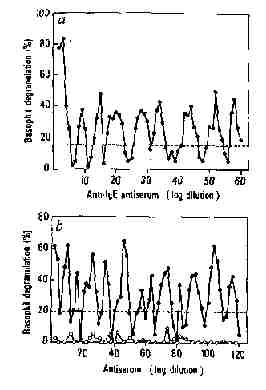
In
June 1988 the journal Nature, the gatekeeper of scientific orthodoxy,
published Benveniste's ultradilution (homeopathy) paper. The implications
of this work are revolutionary, a paradigm shift it there ever was one.
There are a lot of people who would rather fight than shift. Nature,
the journal, as part of their publishing arrangement with Benveniste,
sent a team to investigate his lab. The team included Randy the Magician,
to look for sleight of hand, Walter Stewart, a biologist and statistician
who had made his reputation as a figure crunching fraud-detector, and
the editor, Maddox himself, who had a background in physics. It did
not, however, include a cell biologist who might understand the nuances
of Benveniste's experiment. The team had already made up their minds
(as Walter Stewart wrote in "Omni"). They knew there had to
be a problem with the experiment because in their view the experiment
was impossible. In the lab, Beneviniste and his team demonstrated the
phenomenon to them three times, but the Nature team had determined before
hand that it was an impossible experiment, and not knowing what else
to doubt they decided that they couldn't trust Beneveniste"blind".
The visiting team therefore insisted on adding their own "blind"
to the procedure. To do this they introduced an extra manipulation of
the samples (they moved the samples into new tubes). Of course this
added procedure might or might not effect the outcome of an already
delicate experiment. The investigating team sealed their extra code
in an envelope, wrapped that up in silver foil (to foil X-ray eyes),
and stuck it on to the ceiling of the lab with a video camera trained
on it.! When, in this one trial, this new variation of the experiment
no longer worked, Maddox announced that the whole affair was a delusion,
or a fraud. Such is the stature of the journal, Nature, that the "expert's"
pronouncement was treated with gravity. "In our view, ultradilution
should not work. Therefore it does not. Trust us. We've looked. We've
tried it." (I paraphrase.) This was all every unscientific, yet
here the matter rests. (Work by
Professor M Roberfroid, Madeleine Ennis, and colleagues, has since
vindicated Beneviniste's work and homeopath.)
Now our name was on this controversial Benveniste ultradilution paper,
and we're a very respectable laboratory, so there was a large section
of the world, at least here in Canada, that looked to us to see what
we'd finally have to say on the matter. "We have promising preliminary
results," was all the Professor could say. That, and "No comment."
So when MAME stumbled on the incredible... that DNA diluted (one part
in ten) eighteen or twenty five times (diluted beyond substance) still
binds its complementary strand - they came to see us.
MAME, as I have mentioned, is my acronym for Prof. M. AbouHaidar and
Dr. M. Eweida. Prof. AbouHaidar is a virologist; a Professor with tenure
at the University of Toronto. Professor AbouHaidar was working on a
viral assay. You'd take a plant from a field - he was working with potatoes
(10) - grind it up, run it through the Professor's assay, and it would
tell you whether there was any of a particular virus present in those
potatoes. It works like this: you take a virus, which in this case was
a DNA virus, and you "digest it", splitting each bit of viral
DNA into two single complementary strands. Then you divide this digest
into two parts. At this point the two parts are (statistically) identical.
Take one half of this now single stranded DNA and call it the "target".
Take the other half and call it the "probe".
The target is spotted out on a filter paper - that is to say, you put
a drop of it on a microfilter to make a spot. Then you dilute what's
left one part in ten, and put a drop of the dilute solution at a second
spot. Then dilute again one part in ten, and spot it out again. Keep
diluting and spotting out the successive dilutions. This is to test
how sensitive the assay is. After all, we may be looking for a little
bit of virus in a whole field of potatoes. We need a sensitive assay.
Having spotted out all these successive dilutions, we take the filter
paper and bake it at 80 degrees centigrade. After baking, the target
won't wash off. Next let us consider the probe. The probe, remember,
in this explanation, the probe is made up of the same single stranded
viral DNA fragments. These we're going to label so we can see them.
We mix them with avidin-biotin. The avidin binds to the DNA, and the
biotin will bind to a stain, so we'll get a dark spot where our DNA-avidin-biotin
binds the stain.
Now we take our probe and wash it over the targeted filter paper. Where
the DNA in the probe finds its complementary strand in the target it
binds to it. Next we wash the probe and target, and only where the probe
has bound to its complementary strand will there be any of the probe
be left. The rest is washed away. Then we 'develop' the probe/target
filterpaper with our stain. Only where the labeled probe has bound to
the target will we see any stain. In the test as set it up, the stain
gets lighter and lighter with each dilution. It's dark, almost black,
in the first couple of dilutions, but fades out of sight at about the
seventh dilution.

That's the assay AbouHaidar was refining. (Actually,
it's Dr. Southern's dot-blot test, so it's called "Southern blot",
though Dr. Western's "Western dot-blot" predates it
and is more widely used.). Mohammed Eweida was
a postdoc working in Prof. AbouHaidar's lab with this Southern blot
assay. Mohammed Ewieda wasn't very happy about his situation. I don't
know why, but he was out of there: he was off to the Karolinska Institute
in Stockholm in the summer: and so, perhaps to kill time, he spotted
out the dilutions eighteen times, even though the staining was lost
to sight at the seventh, and... and he got a dark spot at the eighteenth
dilution!

"Look
at that," said Dr. Eweida to Michael Dobbs, a postgraduate student
working in the lab. Some months before Mike Dobbs had been to Jacque
Benveniste's lecture on ultradilution. (In Homeopathy substances are
diluted beyond the infinitesimal till there's no substance left, which
is what is meant by "ultradilution".) So, when Mohammed showed
Michael his anomalous result with an unexpected spot at the eighteenth
dilution Michael thought, incredulously, "ultradilution".
"Eh, Mohammed," he said. "Do that again." Dr. Eweida
repeated the viral assay, this time taking it out to the fiftieth decimal
(one in ten) dilution. (That's 10-50
where ten to the minus 30 is like a drop in the ocean, and 10-37
is like a drop in a million oceans. At 10-26
we pass "Avagadro's number [which relates
to the number of molecules in a "gram molecule"] and
would no longer expect to find a single molecule in a gram.) Again
there was a dark spot that shouldn't be there at the eighteenth dilution,

and
now there were also stained spots at the 19th dilution, and the 25th
and 26th, and the 38th dilution, but not at the dilutions in between.
At the 25th and 26th dilutions there is certainly no substance left
in the solution. We have passed Avagadro's number. There is no DNA
left in the target.(footnote)
And yet the undiluted complementary strands in the probe (labeled
with avidin-biotin) binds to the target! They can not be binding
to a substance, not to molecular DNA. They may be binding to a signal,
an electrical signal imprinted into the nitrocellulose. They are binding
to something!
At first sight, to some, this has seemed to contradict classical science.
"How can water, with nothing in it, remember what was there formerly,
but is no longer there?" But here were Prof. AbouHaidar and Dr.
Eweida, here they were with these filterpapers, dozens of them, with
dark spots at the 18th and 19th dilution, and the 25th and 26th. [Sometimes
the pattern moved a little: sometimes only the 18th turned dark, once
it was the 17th.]
Well,
Prof. AbouHaidar when he first saw it, suspected a joke. And when
Dr. Eweida repeated it yet again, Menir AbouHaidar suspected a hoax.
So he tried it himself, and there it was. No hoax.

What
to do next? One of the next things that MAME did was to come and see
us, Dr. Pomeranz and his research team. From here on in I'm going to
call Dr. Pomeranz, the Professor. The Professor's lab (where I had worked
for seven years) was one of the labs that replicated Benveniste's work
with ultradilute antigens. The Professor's name was on Benveniste's
controversial paper, so MAME came to talk to us, in confidence, to hear
what we could tell them. "Do it again," we said. And they
did...
What does all this mean? It suggests a multitude of things. First let's
look at the patterning of water. If you put, say, one part salt in a
hundred parts of water, it seems that the salt will pattern the water
- the water mirrors the salt's "vibration". Certainly with
MAME's DNA we seem to see an electrical patterning that comes back into
register with the original space/charge patterning at the 18th dilution.
Now if homeopathic [ultradilute, potentiated] remedies
are having effects on organisms - they cured my cat - one of the implications,
it seems, is that the body has vibrational fields, patterned energy
fields, on which these (vibrational, patterned) remedies can work. Many
people, particularly those on the fringe of science, and beyond, have
been saying this for years. But no one has demonstrated it in any convincing
or replicable manner. This is where MAME's discovery is so special.
Finally we have a handle into this realm of vibration.
How does homeopathy work in practice? At its simplest level, let's say
you're in an accident, traumatised, the body goes into a particular
pattern of vibration, in this case a kind of 'shock', Often people seem
to get stuck in these patterns. Tinctures made from the plant Arnica
have a vibratory pattern that (we may imagine) closely
resembles this vibratory pattern associated with traumatic shock. Empirically
it has been observed, again and again, that the potentised remedy prepared
from Arnica helps physically traumatised people to heal. So, it may
be that the body becomes locked in a particular oscillatory pattern,
and the remedy, the "similar", helps to jog it free, to loosen
that pattern's hold on the body so the body can stop repetitively singing
that song.
A further implication of homeopathy is seen in the fact that the personality,
the emotional make-up, the thought patterns, of patients are the most
important guiding feature in deciding which remedy to use. The "mentals"
are given more weight then the physical symptoms. The implication of
this is that mind, that thought and emotion, are patterns.
Come back to the one part salt in a hundred parts water. If we take
this salt water and dissolve it again one part in a hundred in clear
water, and shake it, it again patterns the water, but this time with
some changes. Remember it's at the 18th and 19th dilution that MAME's
target bound the probe (at least, that was the case in the first sample
that MAME showed us). At the 15th, 16th, there was nothing. This suggests
that we are seeing something similar to the interference phenomenon
that occurs with harmonic overlays. This is a fairly well know phenomenon
(e.g. "Poincare's recurrence", see below). However here because
it's a dilution procedure, the harmonics are going to include lower
frequency multiples, "subharmonics", of the original signal
as well as the more usual higher frequency harmonics.
Imagine a conjurer's rope. Take a segment out of that magician's rope
- say one foot out of ten - and hold it taut between your hands, and
twang it. Now (by magic) put it back in the original rope. The note,
the vibration, in the small piece will pattern and inform the longer
piece. The longer piece will now carry that information, but it will
also, during the process, generate harmonics, multiples of that original
note. But note, in the dilution process (which the homeopaths have traditionally
called "potentiation") it becomes intuitively apparent that
we will be generating both harmonics and subharmonics of the
original pattern. And this explains one of the mysteries of homeopathy.
In
our thought experiment we have spread the vibration (the moving rope)
from one unit of length along in to ten units. (I'm not sure I have
the physics and maths right here: but) we might expect the amplitude
of the signal to fall to 10% of what it was, and so if we simply repeat
the process the signal is going to disappear. However, in homeopathy
and ultradilution we "succuss" the system, agitate it (see
footnote "S") throw white noise
through the system. As discussed, briefly, below vibrations, when they
resonate, can "drive" or "amplify" one another:
so the "white noise" from the succussion, where it resonates
with the vibration/signal in the solute, it will drive, or amplify,
the signal. However, where it does not resonate it will simply pass
through. It is as a source of this
amplification that "succussion" is so critical.
It is part of the traditional homeopathic wisdom that the higher potencies,
the higher dilutions, are stronger and deeper acting than the lower
potencies: that the mother tincture and the low potencies act superficially,
at a surface level, at skin level, and at the physical level, while
the high potencies act deeper and begin to effect emotions, thoughts,
personality - and they are also, the high potencies, much stronger.
If I were going to treat you, say, with salt, sodium chloride (in Homeopathy
we latinize it and call it Nat mur, short for Natrium muraticum)...
Now why would I treat you with Nat mur. Nat mur is one of the polycrests,
which is to say it has power over an extremely broad range of symptoms,
and with Nat mur, for sure, I would be guided in large part by personality
and etiology (causation). Nat mur is seen in problems caused by grief
where the person internalises. With that internalizing there's a withholding
and a holding. The person is likely to brood. "Attachment"
is a key word with nat mur, and yet they don't like to be consoled.
Consolation will irritate them. The substance, salt, will cause (this
pattern, this disposition) these problems, and it will also cure them.
That's why we call this type of medicine homeopathy: we treat like with
like. This thought, that "like cures like" was Hahnemann's
great "law". Now this, to me, is not intuitively apparent.
But it is a piece of empiricism that was first recorded by Hippocrates,
was reiterated by Paracelsus, and explored and developed into a fine
art and science by Hahnemann at the end of the eighteenth and the beginning
of the nineteenth century. Hahnemann experimented on himself. His first
experiment was to take quinine. Quinine gave him ague-like fevers!
[Why does like cure like? I don't know; but bare in mind that the symptoms
are not in the remedy any more then they are in the agents (germs, exposure,
whatever) that cause the disease. The symptoms are the body's response
to the substance or cause of disease. My friend and teacher Michael
Vertolli likes to stress that the symptoms are the bodies best response
to the "disease", and that if we suppress the symptoms the
body will then look for its next best response.]
We come across this homeopathic "hair of the dog..." in other
places. Not in immunization! That's a hair of different dog, an essentially
different process. There the body becomes sensitised to a small quantity
of a substance: the immune system comes to recognise and is primed to
respond to a subsequent exposure. No, the two echoes of homeopathy I'm
thinking of are Clinical Ecology and "hormesis".
Clinical Ecologists deal with environmental hypersensitivity. One of
the chief treatment modalities is to give a hair of the dog. Having
identified, by challenge, the substances which cause a patient to produce
symptoms, a dilution of that same substance is found, again by challenge
- by presenting the patient with it - a dilution is found which will
neutralise the symptoms and protect the patient. What they are doing
here is essentially "homeopathy", though here "same cures
same" rather than "like cures like". The dilutions used
by Clinical Ecologist, the "Miller dilutions", are in the
pharmaceutically range. They start with a 1 in 20 mother serum, Miller's
0, and then dilute 1 in 5, so Miller's 1 is 1 part in 100, Miller 2's
is 1 in 500. Typically they are going to find their neutralizing does
at around the 4th dilution (Miller's 4 is 1 in 12,500). Clinical Ecology,
then, is treating like with like, but it is not using ultradilutions.
A second echo of homeopathy is seen in hormesis. In 1987 the journal
Health Physics devoted a whole issue to reporting on a conference on
hormeosis"Hormeosis may be characterized as a process whereby low
doses of an otherwise harmful agent could result in stimulatory or beneficial
effects. The phenomenon of hormeosis is commonly found in nature in
biological response to harmful chemical and physical agents" (2).
"A biological, physiological or biochemical response to a drug
at a low dose may be completely opposite to that response when a larger
dose is administered. Hormeosis is often used to denote the beneficial
response of an organism to a low dose of a physical or chemical agent
and a detrimental response to a much higher dose. ... Examples ... can
be found among these agents: alcoholic beverages, anaesthetic gases,
barbiturates, some tranquillisers, many vitamins, caffeine, nicotine,
salicylates, enzyme induces and some toxic metals" (3). It is also
seen with radiation. It seems then, that this idea, that at some
potency like antedotes like, is an established (if little known)
principle.
So back again to salt: say I'm treating someone with Nat mur, classically
I would start with a low potency, a 6CH (CH for "centisimals Hahnemann",
which is to say, we dilute the salt one part in a hundred, and then
again one part in a hundred, and repeat this process six times). After
we had begun to clear the patient with the 6CH, we might go on to 30CH,
and then to 200CH. In a weak, ill patient the 200th dilution might be
too strong to start with. If we start with 200C we might, in a sensitive
patient, cause a serious "aggravation". Again, the homeopathic
wisdom is that the higher potencies are stronger, and that the lower
potencies work at the physical level, while higher potencies begin to
effect emotions and mental aspects. Hitherto the why or wherefore of
this has been a mystery. Once we see the high potencies as low frequency,
the reason for their strength becomes apparent. At least, I see two
apparent reasons. First, the material substances, the mother tinctures,
are vibrating at very high frequencies: frequencies in the megahertz
and gigahertz range, and beyond. That's millions and billion of cycles
per second. And these high frequencies have effects on atoms and molecules,
but they're out of the range of more complex larger systems such as
the nervous system. However, lower frequency patterns may interact with
the patterns generated in organism as a whole and in its nervous system.
The second reason came to me one evening while standing out on our "deck"
with my friend Darrell. There was a large basin there filled with rain
water. Darrell started jiggling it with his foot. When he jiggled it
rapidly we saw choppy little waves. When he rocked it more slowly he'd
generate larger waves that almost jumped out of the basin onto the deck.
Low frequency waves, here, tended to have larger amplitudes. They had
more "umph"
A few days after MAME came to see us, my head swimming with the confirmation
of ultradilution as a phenomenon and all the thoughts that that spawned,
I had an insight of such far reaching consequence, that created so many
"closures", I came to call it "the great thought".
I think (when the great thought came to me) I was thinking about the
fact that, according to homeopathic wisdom, it is the selection of the
correct remedy, the ideal "similar", that is crucial; while
the selection of the potency, of which particular dilution is given,
is of much less important. But with MAME we see that the 18th, 19th,
25th, 26th, bind DNA. Intermediate dilutions fail to bind the cDNA.
The active "pattern" is there at some dilutions, but not at
others. With each dilution we create changes in the manifest pattern.
All the information may still be there, implicitly, but the manifest
patterns change. To explain this let me tell you about an example Ian
Stewart gives of "Poincare's recurrence".
If we take a picture, say a portrait of Poincare (a nineteenth
century mathematician and a great hero to students of "Chaos Theory"),
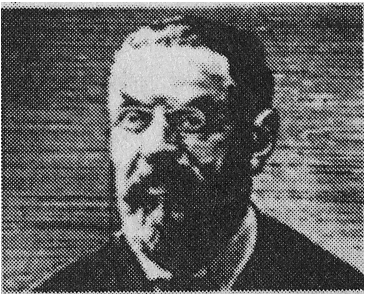
if we take this picture and stretch it out diagonally, and then fold
it back on itself, needless to say, we distort the original picture.
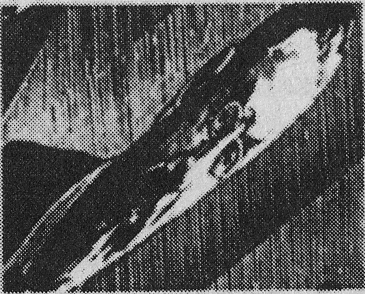
If we take the new distorted picture and repeat the process, stretch
it out and fold it back on itself, by now the original picture is indistinguishable.
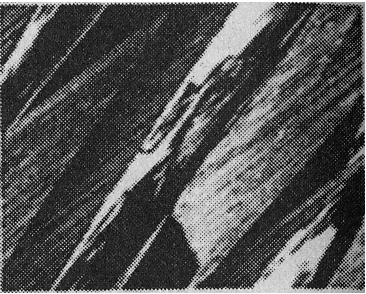
Go on repeating the process, stretching and folding,
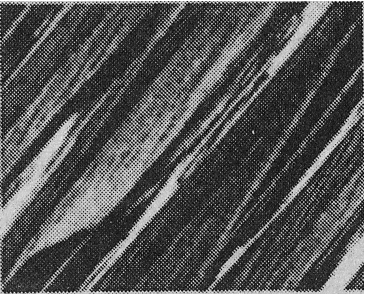
until there are just these squashed together diagonal "lines"
like an out of kilter T.V. set.
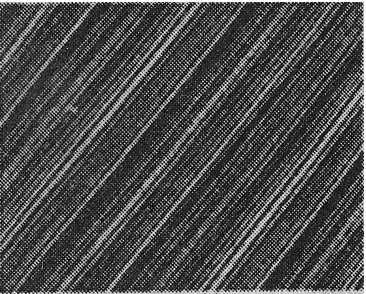
Note that this process is at once an "iteration" and also
a close analogy to the generation of harmonics. If we continue with
this process we will see something quite remarkable. At the 48th iteration
we will see multiple facsimiles of the original portrait superimposed
on one another,
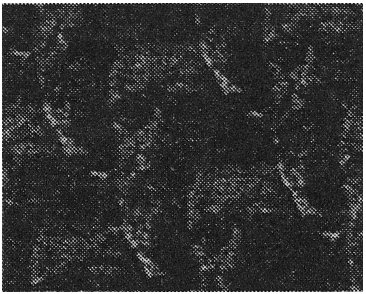
and then at other stages in the process a complete representation of
the original picture returns!
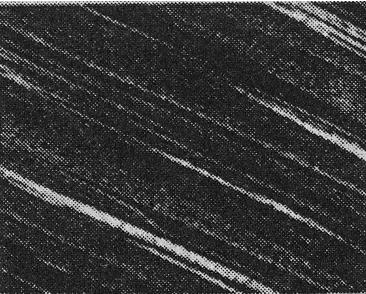
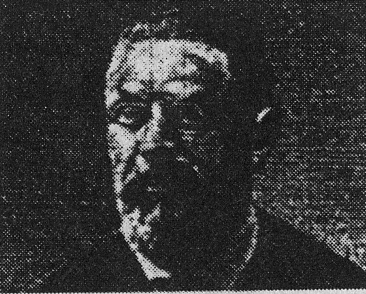
The first complete return is at the 241st iteration. "If a transformation
is applied repeatedly to a mathematical system, and the system cannot
leave a bounded region, it must return infinitely often to states near
its original state" (4). Meanwhile we see that with each iteration,
or with each dilution, we change the pattern, the information, as it
is manifested. And with MAME's DNA the pattern comes back into space/charge
congruence with the original pattern at the 18th and 25th "iteration".
But for a homeopath, it isn't crucial to give the 18th or the 25th.
Any potency will do! One potency may cause an aggravated "healing
crisis", where another just simply cures, and these responses are
not predictable - though we do have the rule that the higher potencies
give a deeper and stronger response - but ultimately the "cure"
will be effected regardless of the potency. The homeopath does not have
to hit on the 18th or 25th dilution of DNA. However, if only certain
potencies match "reality" (manifest congruence with
the original spatial distribution of charges), then the body
must ring through these changes - the body itself must accomplish this
information processing, these permutations that we see with the iterative
successive dilutions.
I think it was this that sparked "the great thought". A penny
tumbled and I thought I had the answer to just about everything. I will
write of that in another place. Meanwhile, I started brimming over with
excitement. "What's got in to you?" my wife asked. So I told
her. "It's the answer to almost everything," I finished. "Says
you," she said.
The next morning I walked briskly into the lab still aglow with the
power of my new insight. I found the Professor and our colleague, "The
Physicist", engrossed in trying to remember the details of MAME's
"hybrid" (target and probe) ultradilution experiment.
"I've had this great thought," I said.
"How did they divide the virus into complementary strands,"
asked The Physicist. So Jonathan (a postgraduate student in our lab)
and I explained the experiment. (I guess it's quite complex if you don't
have a background in genetics.) And then I asked if they'd like to hear
my great idea. "Write it down," said The Physicist.
"You're sure you don't want to hear..."
"No. Write it up. I'll read it," said the Physicist.
"Wait
a minute," said Professor Pomeranz. "He might be on to something.
No one will listen to him."
"Do
you want to hear?"
"No, not now,"
said the Professor. "Write it down." Meanwhile
The Physicist was saying that what puzzled him, and boggled most physicists
who gave it any thought, was the fact that homeopathic remedies seemed
to defy the law of conservation of energy, one of the most basic tenets
of science. You see the remedies last for years and years (there are
some of Herring's remedies from early in the 19th century, still around,
and still apparently "potent") and yet the remedies seem to
radiate: there are those who say you only need to be carrying the remedy
to feel the effects. You can have it in your pocket. Then again, Jean
Munro, a Clinical Ecologist, reports patients coming out with rashes
on their hands, like stigmata, simply from holding a phial of diluted
(potentiated) antigen. "Try wrapping it in metal foil," advised
Cyril Smith (another physicist). Screened with metal foil or gauze the
remedies no longer provoked a skin response. Further, metal gauze of
one dimension will screen out the signal while a different sized gauze
will allow the signal to pass. This suggests that the effects are radiated.
But if remedies are radiating, then they use energy. They should run
down. With time they should become inert. It is for these sorts of reasons
that the journal Nature, and "straight" science, have so much
trouble with Benveniste's ultradilute antigens. Homeopathy seems, at
first sight, to demand a whole new physics. At second thought, though,
perhaps it just demands a little mental agility, a little flexibility.
The natural world loves pattern. We see this in the study of "Chaos".
Nature spurns and rearranges the random much like she abhors a vacuum.
But in order to see a pattern we need a clean field. If we had put our
salt into muddy water the signal would be lost in the "noise".
A clean (smooth, featureless) field invites patterning. At that time
when all these thoughts were falling into place I recall going up stairs
into my daughter's attic room. Her walls were covered in postcards;
among them a photograph of the ripples in the sand on a beach.
If you run water over a smooth plane of sand you will create a rhythmic
pattern: or blow two winds (at different heights) across the sky, and
see the ribbing in the clouds. Nature adores and adorns itself in patterns.
Indeed, The Physicist himself had worked on how calcium ions in an insects
egg fall into a linear spatial rhythm that then divides the animal into
thirteen segments. So let me ask you to bear in mind this propensity
of nature to fall into patterns: think, for instance, of water running
past a rock, and the shock waves, standing waves, folding back upstream.
My "great thought" sent me running to the library to look
up texts on crystals, and this found me thumbing through a book on magnetic
glass (7). The interesting thing about amorphous liquids, said the authors,
is not their chaos and their randomness, but rather how closely in their
behaviour they resemble crystals, and display order. In "non-crystalline
materials... so many properties differ hardly at all from those of crystals".
Give water half a chance and it will carry a message, and this message
may be the key to our understanding the further ordering of the world,
and the mind.
Grant, for a moment, that if we put salt into water it patterns the
water. Think of that pattern, if you would, as a snowflake. There are
millions of different ways to be a snowflake. Then think for a moment
about a stringed instrument. When we pluck the string there are only
certain ways in which that string will vibrate. The whole length of
the string can vibrate; or we can get multiples of that frequency (fractions
of that wavelength), that is "harmonics"; or we can have,
and will have in practice, an overlay of the fundamental note and its
harmonics. But the fundamental note and its harmonics are the only vibrations
that fit our oscillator. These are the only patterns we will commonly
find in our plucked string. Tones, notes, that do not resonate, that
are not stable, will disappear.
Back to our pattern in water, our snowflake, or salt "pattern",
or DNA "pattern" in water: there are only certain ways the
water vibrations can be set up as a stable pattern. What's vibrating?!
Ionic dipoles. In standing waves. Setting up patterns, like snowflakes.
And there are, in all probability, an infinite number of ways, of patterns,
that the oscillating dipoles can take, but there are infinitely more
patterns that aren't stable. So there are an infinite number of ways
in which the water can resonate, like snowflakes, and an infinitely
greater number of patterns which don't resonate, and this is what gives
the patterns their permanence. Between one resonant pattern and the
next nearest stable resonant pattern there are infinite ways of vibrating
that are not resonant, that decay. It's like the energy hills and troughs
that are used as an analogy to explain the stability of electron shells,
and of molecules for that matter. Now in that analogy it is the very
law of conservation of energy that keeps the electrons in their orbit.
With homeopathy the mechanism is a little different. In so far as the
water (dipoles) fall away from the pattern, they fall into chaos and
the pattern dissipates, and no doubt this happens. But meanwhile, through
resonance (through a process akin to "entrainment") the system
is capturing new energy that will amplify the already established patterns.
Let's talk a moment about the general properties of vibrations. Vibrations
do three very wonderful things: they "resonate", they can
"amplify", and they "entrain". We've talked about
resonation in the previous paragraph. There are just certain ways in
which anything (a violin, a bottle) will vibrate, and if the energies
impinging on that object match (to a certain degree) those patterns,
they will drive those patterns, and the object will vibrate in sympathy
with that driving force, or "resonate". This resonance allows,
in certain situations, for amplification of the signal.
I can illustrate what we mean by entrainment by telling you about one
of Pomeranz's ultradilution runs. Remember, he was trying to duplicate
Benveniste's ultradilute antigen findings, so the lab was making up
serial dilutions of antigens to human basophilic white blood cells to
see if these "homeopathic"-antigens would cause histamine
release from the basophils. In one particular run we seemed to get degranulation
at two separate intervals with these two patterns overlapping, summing
with one another (in a linear fashion), and in that, to some extent
hiding each other. This was the apparent pattern in the low dilutions,
up to about forty-five, and then these two waveforms (when plotted out
in a graph of successive dilutions they appear as waves) seem to "entrain"
each other - a "compromise" was reached - and thereafter we
saw peeks and troughs with a new periodicity. So with entrainment we
have two periodic functions and they "entrain" one another
to give one resultant function. This indeed is part of the essence that
makes an oscillation "non-linear": where two periodic functions
don't simply sum, but interact, we say they are "non-linear"
- that is, they don't add together in a linear fashion like the waves
in a pool.
Back to the Physicist's question, why don't homeopathic remedies dissipate
there energies? They do! but meanwhile they're capturing and structuring
energies. The remedy sits there on the shelf, radiating its signal:
however in the meantime it is catching and interacting with the seismic
vibrations, and other energies, that are incident upon it, and where
these incident vibrations resonate with the remedy, they drive it, they
energise it.

How
do I know all this is what is going on? I don't. I do know that homeopathy
cured my cat. I know that MAME's ultradilute DNA bound molecular DNA
And then we have the well conducted clinical trials of Reilly published
in Lancet that demonstrate beyond reasonable doubt that a phenomenon
exists. Homeopathic remedies are reproducibly significantly more effective
than placebo controls (Reilly 94). We know the phenomenon exists. What
I've written here is my groping for an explanation.
The physicist, Del Guidice, after hearing Benveniste speak, went back
to his lab and started to look at the mathematics and physics of dipole
oscillation in water. The result is four pages of equations unfathomable
to a layman. The conclusion is that such oscillations do not consume
energy - like the electrons orbiting round atoms in their electron shells,
the oscillating dipoles are energetically neutral - once a pattern of
oscillation is set up in dipoles in water it will continue to vibrate
.. forever." (9)
One of the further experiment that MAME has undertaken is to try a slightly
different strain of virus, potato virus X, in place of potato virus
S, as the probe to see if DNA would simply binding to another strand
of any DNA, or if the specificity of the particular piece of DNA to
its specific complementary strand of cDNA was essential to the phenomenon.
And indeed they found that a virus X probe would not bind to any dilution
of a virus S target. It was specific. To check that there was indeed
no substantial residue left in the ultradilution, MAME labeled their
target with radioactive P32: and yes, they demonstrated that there is
no substance in the ultradilute target. It is informative that we see
activity in adjacent dilutions, in the 18th and 19th, in the 25th and
26th, (and that they move around a little, shifting sometimes to the
15th, or 16th, or 17th, for instance), for this suggests that we are
slowly generating (and "stretching out") the "harmonics",
rather then doing some flip-flop with the dipole patterns.
In May 1989 MAME submitted a paper on this ultradilute DNA phenomena
to Nature. And Maddox, the editor, sat on it. In the summer of 1989
the University of Toronto opened a new botany building, and Prof. AbouHaidar
moved his lab out of its old quarters. After the move and some initial
difficulties for a short while the ultradilute experiment ran as before,
though the pattern (18, 19, 25, 26) became more chaotic. But then shortly
after the move, they lost the phenomenon! It no longer worked. They
tried it a few times, and moved back to their mainstream work, genetic
engineering, with the world not even ruffled.
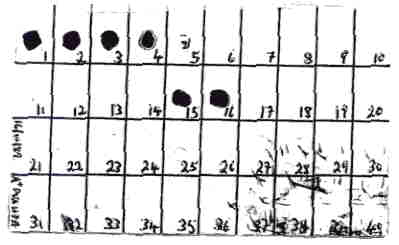
Post
Script: Chasing the Unicorn.
In the summer of 1992 I started teaching at a school of Homeopathy.
I took the position in part to motivate and position myself to follow
up on MAME's work. At that time I was approached by Elizabeth Huston,
a Ph.D. candidate, who wished (while finishing off her doctorate in
biochemical neurophysiology) to conduct some research in alternative
medicine. I spoke of MAME's work and my desire to replicate it. We approached
Prof. AbouHaidar and told him of our intention to explore the phenomenon.
Professor AbouHaidar invited us to use his laboratory and facilities.
The MAME's (AbouHaidar-Eweida's) Southern dot-blot assay takes three
days to complete. Over a period of six months in 1992 through to March
1993 Elizabeth Huston and I ran different permutations of MAME's protocols,
and learned what we could about their lab and their procedures. As far
as we could gather, their procedures varied over time. It is hard for
us to establish exactly what was done at particular times. For example,
the first time Elizabeth ran the assay AbouHaidar advised her that succussion
(vortexing) was not required and had not often been employed. Their
protocols, however, call for 20 seconds of vortexing. Michael Dobbs
informed me that more typically 5 seconds of vortexing was employed.
The second time we ran the assay, I succussed by hand delivering about
15 taps to the vials between dilutions. In this second assay I also
turned off the fluorescent lighting - we do not know which factors are
relevant. The DNA provided to us on that occasion proved to be rather
too dilute, faded out between the second and third dilution! Nonetheless
we saw a faint "ghost" of a response at the 15th dilution.
This was to be the only time we saw any hint of the phenomenon. We also
learned that Eweida had run successful assays with "crude saps"
and in electrophoresis gels. Again, we were not able to replicate this
work.
There are many different factors that might account for the "loss"
of the phenomenon with the move, the change of laboratories. We were
able to enumerate some of these, but we were not able to isolate them.
Let me list some of them. (Much of my information comes from Charles
Braid, the former chief engineer in the University's Works and Utilities
department, and from Ken Pollyiak his successor, to whom I am grateful.)
The original botany laboratory, where the assay worked robustly for
six months, was a nineteenth century building on the corner of University
and College Street. (It is now called the Tanz Neuroscience Building.)
It is built directly on top of an underground river, Taddle Creek. The
water table is close to the surface (8 foot). The greenhouses adjoining
the Tanz building have a water pump in constant operation to drain the
foundations. The new botany department, on the other hand, is built
of dry ground, and there are "electrical anomalies coming out of
the ground".
The first work was conducted in a ground floor laboratory. The ceilings
were high. The windows were single glazed and could be opened. Humidity
was maintained at 20%. The new lab is on the fourth floor; the windows
are double glazed and do not open. Humidity is 35%. Outside the window
of the new lab there is a 30,000 volt power line. The original work
was done on an old stock of "gridded" nitrocellulose paper
donated by another lab.
When they first moved to the new lab in July 1989, a summer student
was put onto the assay. He was unable to reproduce the phenomenon. Michael
Dobbs then attempted it. He used water from the old laboratory, and
subsequently found that the assay would work with any water except the
double distilled "multiplex" water used by the summer student.
(The on-tap distilled water in the old lab was steam-stilled with a
resistance of 1.8 Mohm. In the new building the reverse osmosis water
on-tap has a resistance of 16 Mohm.) The phenomenon worked robustly
for Dobbs in late summer, though in the new building the "pattern"
shifted. It was no longer always the 18th and 25th dilution, but scattered
unpredictable dilutions that were active. Dobbs tells me that the 18,
25 pattern was particular to the PVS virus. By October of 1989 Michael
Dobbs withdrew from the project, for "political reasons".
It is not clear whether the procedure was still robust when Eweida and
another colleague resumed work in October 1989. They saw the phenomenon
a few times, and then lost it.

It
was not my impression that procedures, protocols, were clearly and precisely
defined in AbouHaidar's lab. (Elizabeth once characterized their work
as "bucket chemistry".) Nonetheless the phenomenon seemed
to be robust up to the move, and for a short while after the move. As
far as I am aware, apart from Elizabeth and my follow up in 1992/93,
there has been no further work done with the phenomenon.
[I was talking in 1994 with a young student from Guelph, Tom Ikam, who
was running a sensitive bioassay with "Con-A", a substance
that stimulated T-cell activity. He tried some ultradilutions and saw
ten fold enhanced biological activity at eighteenth decimal dilution!
So far, unfortunately, he has not had accesses to the lab to attempt
replication.]
Was it all a hoax? That seems hardly likely. Prof. AbouHaidar is a full
professor with tenure at a major university. When he submitted his paper
to Nature (and later to Science) he put his reputation on the line.
If he had had the least suspicion that a fraud, prank, or hoax was involved
he would not have risked the ridicule. MAME's phenomena was real! I
saw the filterpapers with their dark spots, 1st, 2nd, 3rd, 4th, 5th,
fading out between the 6th and 7th dilutions, and back as dark as ever
at the 18th, 19th, 25th, etc. Furthermore, homeopathy works! Clinical
trials show that it works (5, 6,). We have the same clinical empirical
scientific evidence that homeopathy works that we have for standard
pharmaceutical - no more, no less. Given this phenomenology, MAME's
phenomenon was simply a confirmation of something that has already been
amply demonstrated to exist. What was so exciting about MAME's assay
is that it could afford us a means to manipulate and examine the phenomena.
The fact that when MAME moved labs the phenomenon vanished is itself
fascinating.
When we begin to understand the level of organisation of matter indicated
by homeopathic ultradilution we will have in our hands a new tool: a
tool with which we may be able to open new doorways of understanding
into such things as mind /consciousness/ experience (again, recall that
"mentals" - personality, thoughts - are the most important
criteria for the selection of homeopathic remedies). And it might be
that if we understood this subtle patterning of water and looked at
how heavy water patterns around palladium electrode in Pons and Fliechman's
heavy water electric cell, we might just get some insight into their
elusive cold fusion phenomenon.
So
I urge anyone who has the opportunity to look for ultradilute activity,
whether in dot-blots or in other assays, to do so. We stand on the threshold
of a new science, a level of patterning in the natural world hitherto
overlooked, and who can say where this knowledge might lead.
Note:
there is some more recent data, and I have tried to embrace this in:
A
discussion of mechanism of "ultradilution" / homeopathic "potentisation":
oscillating dipoles/quantum coherence domains, nano-particles, and such
Some Key Points
a
realisation about the actually remarkable
congruence between Beneviniste's IgE and Eweida's DNA dot blot data
Bibliography
(1) Davenas et al: Human basophil degranulation triggered by very dilute
antiserum against IgE: Nature, vol 333, p.816-818, 30th June 1988.
(2) Cohen: Conference on Radiation Hormesis: an Overview: Health Physics
Vol 52, p.519. 1987.
(3) Furst: Hormesis Effects in Pharmacology: Pharmacological Inversions
as Prototypes for Hormesis: Health Physics, vol 52, p527.22
(4) Stewart: Does God Play Dice: the Mathematics of Chaos
(5) Reilly: Is evidence for homeopathy reproducible?: Lancet Vol 344
p1601-1606. Dec 10, 1994.
(6) Kleijnen et al: Clinical trials of homeopathy: Br. Med. J. 1991
302:316-23
(7) Moorjani and Coey: Magnetic Glass: Elsevier 1984
(8) Del Giudice: Water as a Free Electric Dipole Laser: Physical Review
Letters: 29 Aug. 1988, 61:9:1085-88
(9)
et al and Pomeranz JAMA spring 1998
(10) M. Eweida
et al. J.Virological Methods, 26 (1989) 35-44 "Highly sensitive
and specific non-radioactive biotinylated probes for dot-blot, Southern
and colony hybridizations"
Benveniste vindicate! : read
Guardian article here
see also: P. Belon; J. Cumps;
M. Ennis; P. F. Mannaioni; J. Sainte-Laudy; M. Roberfroid; F. A. C.
Wiegant (April 1999). "Inhibition of human basophil degranulation
by successive histamine dilutions: Results of a European multi-centre
trial". Inflammation Research 48 (Supplement 1): 17–18.
Robustness
and Frailty in Benveniste!
Something
that puzzles and troubled me about MAME
Introduction:
Pattern and resonance in the Natural World
Chapter
2: Living Crystals
|

